The AMD Radeon R9 Fury X Review: Aiming For the Top
by Ryan Smith on July 2, 2015 11:15 AM ESTOverclocking
Finally, no review of a high-end video card would be complete without a look at overclocking performance.
To get right to the point here, overclockers looking at out of the box overclocking performance are going to come away disappointed. While cooling and power delivery are overbuilt, in other respects the R9 Fury X is very locked down when it comes to overclocking. There is no voltage control at this time (even unofficial), there is no official HBM clockspeed control, and the card’s voltage profile has been finely tuned to avoid needing to supply the card with more voltage than is necessary. As a result the card has relatively little overclocking potential without voltage adjustments.
So what do we get for overclocking?
| Radeon R9 Fury X Overclocking | ||||
| Stock | Overclocked | |||
| Boost Clock | 1050Mhz | 1125MHz | ||
| Memory Clock | 1Gbps (500MHz DDR) | 1Gbps (500MHz DDR) | ||
| Max Voltage | N/A | N/A | ||
Our efforts net us 75MHz, which is actually 25MHz less than what AMD published in their reviewer’s guide. Even 100MHz would lead to artifacting in some games, requiring that we step down to a 75MHz overclock to have a safe and sustainable overclock.
The end result is that the overclocked R9 Fury X runs at 1125MHz core and 1Gbps memory, a 75MHz (7%) increase in the GPU clockspeed and 0% increase in the memory clockspeed. This puts a very narrow window on expected performance gains, as we shouldn’t exceed a 7% gain in any game, and will almost certainly come in below 7% in most games.

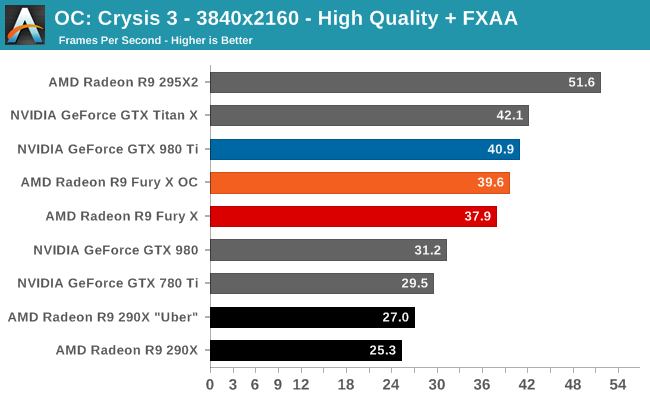
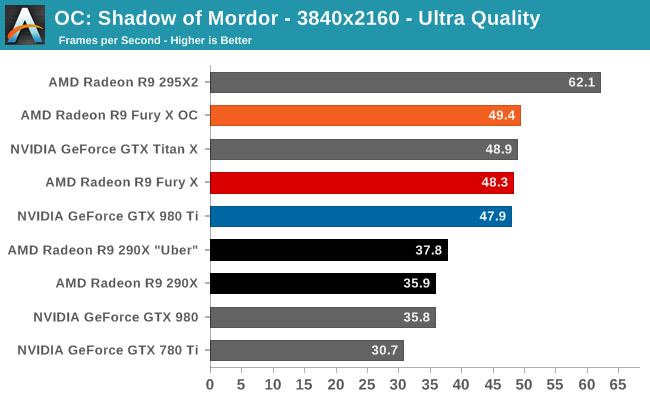
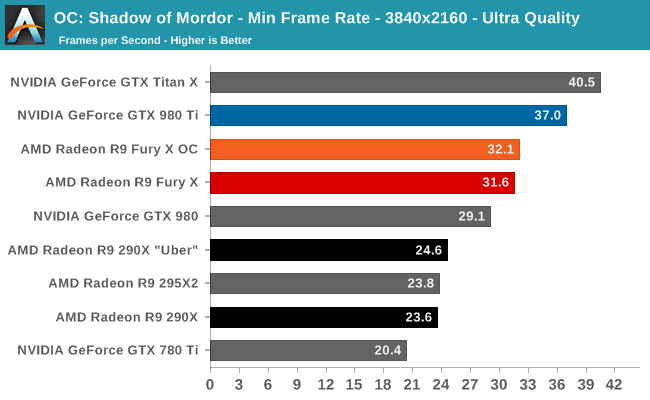

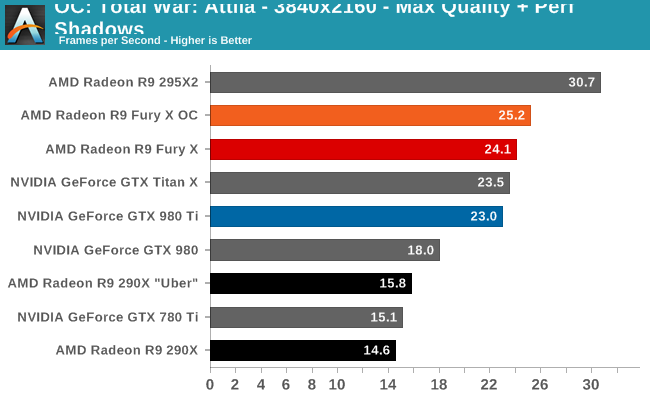
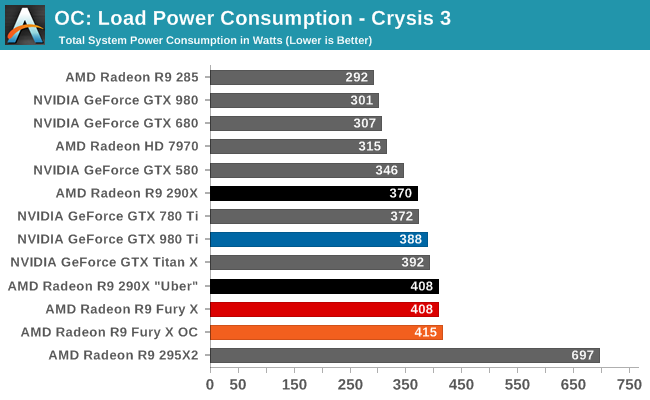


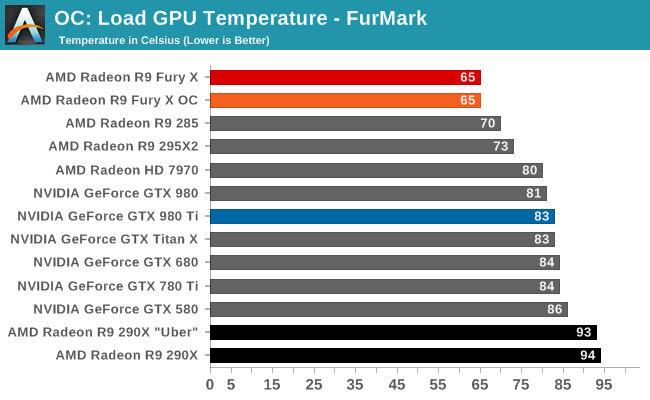

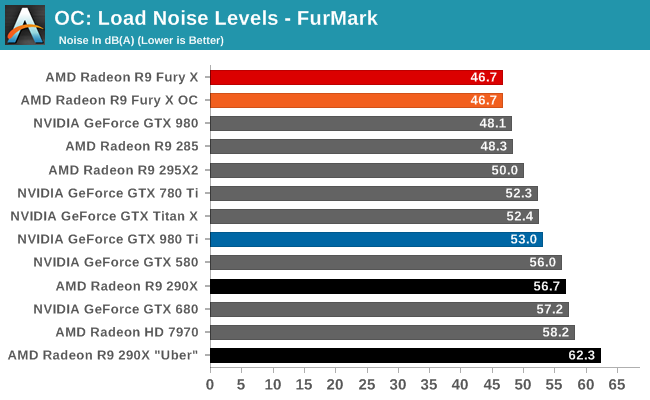
Our gaming benchmarks find just that. A few percent performance improvement there, a 5% improvement there. Overall we wouldn’t go as far as saying there no reason to overclock, but with such limited gains it’s hardly worth the trouble right now.
True overclocking is going to have to involve BIOS modding, a riskier and warranty-voiding strategy, but one that should be far more rewarding. With more voltage I have little doubt that R9 Fury X could clock higher, though it’s impossible to guess by how much at this time. In any case the card is certainly built for it, as the oversized cooler, high power delivery capabilities, and dual BIOS switch provide all the components necessary for such an overclocking attempt.
Meanwhile HBM is a completely different bag, and while unofficial overclocking is looking promising, as a new technology it will take some time to get a good feel for it and understand just what kind of performance improvements it can deliver. The R9 Fury X is starting out with quite a bit of memory bandwidth right off the bat (512GB/sec), so it may not be bandwidth starved as often as other cards like the R9 290X was.


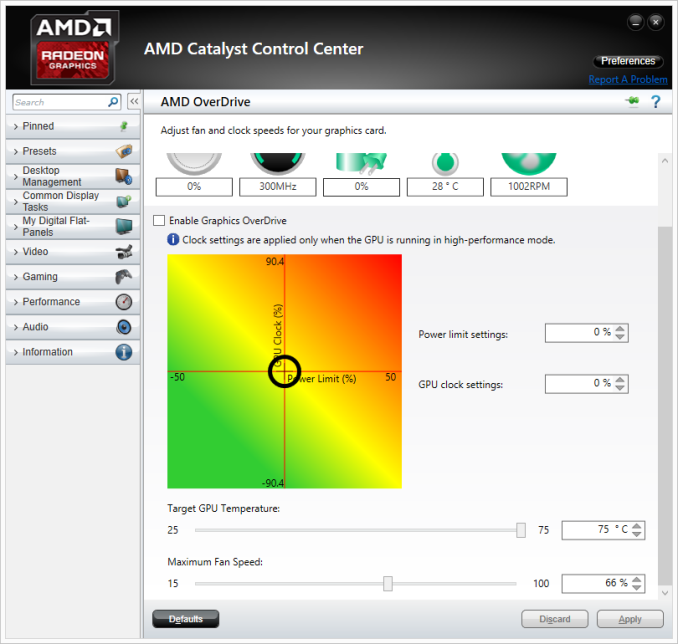








458 Comments
View All Comments
just4U - Saturday, July 4, 2015 - link
I thought it was great as well.. It had a lot more meat to it then I was expecting. Ryan might have been late to the party but he's getting more feedback than most other sites on his review so that shows that it was highly anticipated.B3an - Saturday, July 4, 2015 - link
I don't understand why the Fury X doesn't perform better... It's specs are considerably better than a 290X/390X and it's memory bandwidth is far higher than any other card out there... yet it still can't beat the 980 Ti and should also be faster than it already is compared to the 290X. It just doesn't make sense.just4U - Saturday, July 4, 2015 - link
Early drivers and perhaps the change over into a new form of memory tech has a bit of a tech curve that isn't fully realized yet.Oxford Guy - Saturday, July 4, 2015 - link
Perhaps DX11 is holding it back. As far as I understand it, Maxwell is more optimized for DX11 than AMD's cards are. AMD really should have sponsored a game engine or something so that there would have been a DX12 title available for benchmarkers with this card's launch.dominopourous - Saturday, July 4, 2015 - link
Great stuff. Can we get a benchmarks with these cards overclocked? I'm thinking the 980 Ti and the Titan X will scale much better with overclocking compared to Fury X.Mark_gb - Saturday, July 4, 2015 - link
Great review. With 1 exception.Once again, the 400 AMP number is tossed around as how much power the Fury X can handle. But think about that for one second. Even a EVGA SuperNOVA 1600 G2 Power Supply is extreme overkill for a system with a single Fury X in it, and its +12V rail only provides 133.3 amps.
That 400 AMP number is wrong. Very wrong. It should be 400 watts. Push 400 Amps into a Fury X and it most likely would literally explode. I would not want to be anywhere near that event.
AngelOfTheAbyss - Saturday, July 4, 2015 - link
The operating voltage of the Fury chip is probably around 1V, so 400A sounds correct (1V*400A = 400W).meacupla - Saturday, July 4, 2015 - link
okay, see, it's not 12V * 400A = 4800W. It's 1V (or around 1V) * 400A = 400W4800W would trip most 115VAC circuit breakers, as that would be 41A on 115VAC, before you even start accounting for conversion losses.
bugsy1339 - Saturday, July 4, 2015 - link
Anyone hear about Nvidia lowering thier graphics quality to get a higher frame rate in reviews vs Fury? Reference is semi accurate forum 7/3 (Nvidia reduces IQ to boost performance on 980TI? )sa365 - Sunday, July 5, 2015 - link
I too would like to know more re:bugsy1939 comment.Have Nvidia been caught out with lower IQ levels forced in the driver?